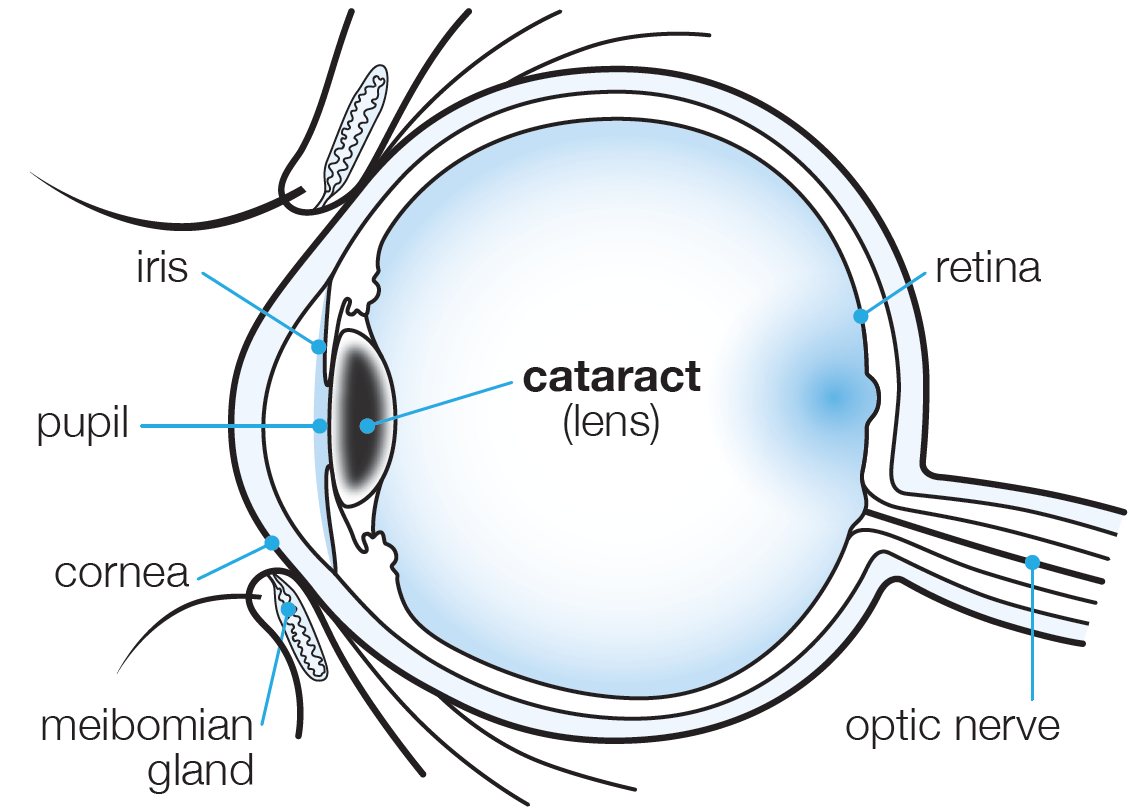Enjoy your best life with clear vision
Your guide to Cataract Surgery is here to help you understand your cataract journey: from your first consultation, to selecting the most suitable Intraocular lens (IOL) for your cataract surgery, and what you can to do after surgery to help you get the best vision outcomes possible.
Our team is here to help you enjoy your best life with clear vision.
(PDF 831kb)
What is a cataract?
A cataract is when your natural lens inside your eye has become cloudy and hard. The lens is the size of a shirt button and is located just behind the iris (the coloured part of the eye). It focuses incoming light onto the retina, which is the ‘camera film’ at the back of the eye.
Cataracts can develop from normal aging, from an eye injury, or if you have taken medications known as steroids. Cataracts may cause blurred vision, dulled vision, sensitivity to light and glare, and ghost images. If the cataract changes vision so much that it interferes with your daily life, the cataract may need to be removed.
Surgery is the only way to remove a cataract. You can decide not to have the cataract removed. If you don’t have the surgery, your vision loss from the cataract will continue to get worse.

FAQs about cataracts
The goal of cataract surgery is to correct the decreased vision that was caused by the cataract. During the surgery, Dr Adams removes the cataract and puts in a new artificial lens called an intraocular lens or IOL. Cataract surgery will not correct other causes of decreased vision, such as glaucoma, diabetes, or age-related macular degeneration.
Dr Adams will help you decide on the type of IOL that will replace your cloudy lens. There are IOLs available to treat:
- near-sightedness (myopia)
- far-sightedness (hyperopia), and
- astigmatism.
IOLs usually provide either near or distance vision: these single focus lenses are called monofocal IOLs.
Some IOLs can provide for near, intermediate, and distance vision: these multiple focus lenses are called multifocal IOLs and extended depth of focus (EDOF) IOLs.
IOLs that treat astigmatism are called toric IOLs.
There is no “better” option – the choice is dependent upon your eye health as well as your visual requirements. Certain eye conditions render particular IOLs unsuitable.
Following cataract surgery you can have reduced dependency on glasses. However, this is dependent on a number of factors including your eye health, which determines the suitability of the IOL type implanted. This will be discussed with you during your consultation.
Cataract surgery is a day procedure and is performed under local anaesthesia. A series of anaesthetic drops are instilled and/or local anaesthetic is injected around the eye. You will also be given a mild sedating drug to relax you. You should not feel any pain or be able to see the surgery while it is happening, and you may not remember the surgery afterwards.
Dr Adams makes an incision less than 3mm long to enter the eye with a special ultrasound instrument. This breaks the cataract into smaller pieces which are then removed by suction – called Phacoemulsification. The IOL is inserted into the eye through the same wound. Usually stitches are not required as the small incision self-seals. Your eye will be covered with a clear plastic shield, this will remain in place until four hours later when you administer your first post-operative eye drops.
Cataract surgery is a commonly performed surgery and the success rate is higher than 99%. We need to let you know about the possible complications below, even if some are very rare, so you have informed consent.
All operations and procedures have risks and can result in unsuccessful results, complications, injury or even death, from both known and unknown causes. Risks of cataract surgery include, but are not limited to: bleeding; infection; pieces of the lens that cannot be removed; high eye pressure; a detached retina and visual changes such as glare or haloes and visual loss.
You may need additional treatment such as extra drops, injections or surgery to treat these complications; this is not included in the fee for this procedure.
You will need to use eye drops after the surgery – these will be provided to you. In the first few days it is normal for the eye to be red (particularly if you take blood thinners); this does not affect the visual outcome. Sometimes the pupil remains dilated for a day or two due to the dilating drops we use during surgery which can make things seem blurry. Most people notice their vision is clearer within a couple of days but sometimes it can take longer for everything to settle down. Different people recover at different rates - this can depend on the density of the cataract removed, the shape of your eye, your age and your pre-existing eye health.
It is very common for you to experience a foreign body sensation or grittiness after surgery. This is where your nerve endings and skin on the eye are healing. Use lubricants / artificial tears for symptomatic relief when necessary.
Your natural lens (cataract) has been replaced with an artificial lens, so you may notice some transient effects whilst your brain gets used to the new lens. These can include seeing a dark shadow in your outer vision which disappears when you hold a hand to your temple like a blinker (negative dysphotopsia). Sometimes you experience a fluttering or jitter in your vision.
These symptoms will fade – it is best to ignore them, in the same way you first notice the rim on a pair of glasses but eventually you ignore it and so no longer notice it unless you look for it.
If you have dry eyes, your symptoms may worsen for a time after surgery – use extra lubricants for relief. Intense Pulsed Light treatments can improve symptoms. Insight Eye Surgery offers the opportunity to help enhance your tear film and ocular surface prior to and shortly after cataract surgery. Intense Pulsed Light or IPL treatments can ease your symptoms. Dr Adams will help you to choose the pathway to IPL.
- Use all the eye drops as directed including any usual drops you use e.g. for glaucoma – start a fresh bottle after the operation
- Wear the protective shield for 1 week at night when sleeping. Do not sleep face down - If you have had a glaucoma stent inserted, sleep on 3 pillows for the first 2 nights.
- Resume moderate physical activity after 24 hours and continue to watch television or read
- Shower or bathe but do not allow tap water to enter your eye for 1 week
- Wash your hands before using your drops or cleaning your eyes
- Use preservative free lubricating eye drops for any grittiness or discomfort (you can buy these over the counter in the pharma
- DO NOT RUB or apply pressure to the eye.
- Avoid windy or dusty situations
- Do not wear eye makeup for two weeks, and when you do, make sure it’s a fresh product.
- Do not swim for two weeks (with goggles) or four weeks (without goggles) following cataract surgery
- Do not drive or operate machinery for 48 hours after surgery
- You should not update your glasses with your optometrist until 6 weeks after the surgery. In this time, if you need extra help for reading you can use over the counter readers.
Contact Dr Adams at Insight Eye Surgery on 07 3154 1515 (Brisbane) or 07 5345 5011 (Noosa) if you have any significant problems, such as severe pain, decreasing vision or worsening discomfort or swelling around the eye. It is not unusual for your vision to fluctuate a little but a sudden or significant loss of vision is unusual.
For after-hours emergencies only, attend the Emergency Department at your closest hospital.
Our friendly staff will discuss where you can have your cataract surgery done by Dr Adams and will provide you with the relevant hospital admission information when you book your surgery. Dr Adams operates at any of these three hospitals:
Noosa Private Hospital, Suite 4 111 Goodchap Street, Noosaville, Q 4566, T 07 5455 9200
Westside Private Hospital, Level 1 Westside Private Hospital 32 Morrow Street, Taringa, Q 4068, T 07 38336701
Buderim Private Hospital, 12 Elsa Wilson Drive, Buderim, Q 4556, T 07 5430 3303
Download the Frequently Asked Questions After Surgery Guide
Download Surgery FAQ Guide (PDF 108kb)
Further reading
There's lots of information available out there about cataract surgery. One common issue is was is termed Surgical Transient Ocular Discomfort Syndrome or STODS. This is experienced as grittiness, itchiness, intermittent sharp discomfort in the eye following eye surgery. It can last from a few days to a few months. You can read more about it here.
Make an Appointment
To make a booking for a consultation or procedure, contact us here >>.
Please have on hand your:
- Medicare card number
- Health fund details (if applicable)
- DVA/Pension/health care card details (if applicable)
- Current referral letter
How much does cataract surgery cost?
Insight Eye Surgery provides a full and open estimate of surgery fees before any procedure. There are numerous treatment options for people without health insurance.


